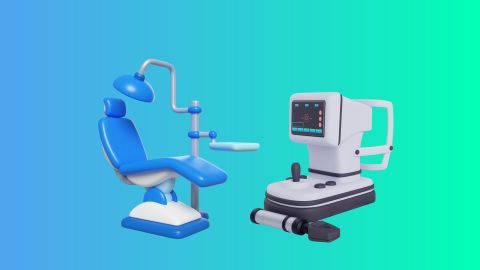What is an anesthesia machine?
An anesthesia machine is a critical piece of medical equipment used in surgeries to administer anesthetics to patients, ensuring they remain unconscious and pain-free throughout the procedure. The machine allows precise control of oxygen, nitrous oxide, and other anesthetic gases, providing an essential role in both minor and major surgeries. Modern anesthesia machines are designed to offer safe, accurate, and reliable delivery of gases while ensuring patient safety during surgical interventions.How does an anesthesia machine work?
An anesthesia machine works by delivering a controlled mixture of gases, including oxygen, nitrous oxide, and inhaled anesthetics, to the patient during surgery. Here's how it operates:
- Oxygen is supplied through the machine and delivered to the patient’s respiratory system.
- Anesthetic gases are vaporized and mixed with oxygen to create the desired concentration.
- The machine maintains a constant flow of gas to ensure the patient remains unconscious and pain-free.
- Monitoring systems keep track of the patient’s vitals, ensuring optimal oxygen levels and anesthesia concentration.
- The machine also provides mechanisms for ventilation, if required, for patients who are unable to breathe on their own.
Types of anesthesia machines
Anesthesia machines come in various types, designed to meet the specific needs of different medical procedures. Key types include:- Basic Anesthesia Machines: Simple, compact machines for low to moderate surgeries.
- Advanced Anesthesia Machines: Equipped with advanced monitoring systems, ideal for high-risk surgeries.
- Mobile Anesthesia Machines: Portable machines used in field surgeries or transport situations.
- Integrated Anesthesia Workstations: High-end machines with advanced features for intensive care settings and complex surgeries.
Key features of modern anesthesia machines
Modern anesthesia machines are equipped with several features to ensure safety, precision, and ease of use, including:- Digital monitoring systems: Track vital signs like heart rate, oxygen saturation, and ventilation parameters.
- Precision flowmeters: Control the exact amount of gases being delivered to the patient.
- Vaporizer units: Accurately vaporize and mix anesthetic agents for precise administration.
- Ventilators: Provide mechanical ventilation for patients who cannot breathe on their own.
- Alarms and safety features: Alert the medical team in case of equipment malfunction or if the patient's vitals are outside safe ranges.
Applications of anesthesia machines
Anesthesia machines are used in various healthcare settings for different purposes, including:- General surgery: Administering anesthesia during routine surgeries.
- Cardiac surgery: Critical for maintaining patient safety during heart surgeries.
- Orthopedic surgery: Ensures patients are unconscious and pain-free during bone and joint procedures.
- Pediatric surgery: Specialized anesthesia delivery for children during surgery.
- Emergency care: Used in resuscitation and emergency surgeries to manage breathing and anesthesia.
Benefits of using anesthesia machines
Using an anesthesia machine provides several benefits, including:- Safety: Ensures precise control of gas delivery, reducing the risk of overdose or underdose.
- Comfort: Allows for better control of anesthesia levels, leading to more comfortable recovery.
- Efficiency: Streamlines the process of anesthesia delivery, saving time during critical procedures.
- Patient monitoring: Provides real-time data on the patient’s vital signs, enhancing patient care.
- Customization: Offers flexible settings to cater to individual patient needs, including age and medical condition.
Price of anesthesia machine in India
The cost of anesthesia machines in India can vary depending on the type and features of the machine. Here's a basic breakdown:| Type of Anesthesia Machine | Price Range (Rs.) |
| Basic Anesthesia Machine | 1,00,000 - 3,00,000 |
| Advanced Anesthesia Machine | 3,00,000 - 10,00,000 |
| Mobile Anesthesia Machine | 2,00,000 - 5,00,000 |
| Integrated Anesthesia Workstation | 8,00,000 - 20,00,000 |
Factors to consider when buying an anesthesia machine
When purchasing an anesthesia machine, consider the following factors:- Type of surgery: Choose based on the level of complexity of the surgeries you perform.
- Monitoring systems: Look for machines with advanced monitoring features for better patient safety.
- Ventilation features: Ensure the machine provides adequate ventilation options for emergency scenarios.
- Space and portability: Consider whether a mobile or stationary machine is more suitable for your needs.
- Compliance with standards: Ensure the machine complies with national and international medical standards.
Maintenance tips for anesthesia machines
Maintaining an anesthesia machine is essential for ensuring its longevity and optimal performance. Follow these tips:- Regular calibration: Ensure the machine is regularly calibrated to maintain accurate readings.
- Routine cleaning: Clean all components, including vaporizers and ventilation systems, to prevent contamination.
- Check gas flow and leak test: Regularly check the gas flow and perform leak tests to ensure safe operation.
- Monitor filters and components: Replace filters and other components as needed to maintain efficiency.
- Service and inspection: Schedule regular service and inspections with qualified technicians to address wear and tear.
Conclusion
An anesthesia machine is a critical piece of equipment for any surgical procedure, ensuring patient safety and comfort. The right machine can make a significant difference in the outcome of a surgery. If you’re looking to purchase one, it’s important to understand the various types, features, and prices in India, as well as the factors to consider for choosing the best one for your medical facility.Additionally, securing finance for medical equipment can make the process smoother. You can explore the Medical Equipment Finance by Bajaj Finance to help cover the cost of your purchase and ensure you have the best tools for patient care.




